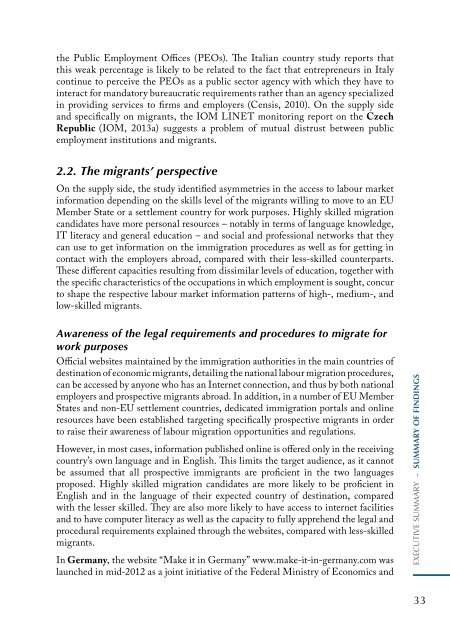International Organization for Migration (IOM)
International Organization for Migration (IOM)
International Organization for Migration (IOM)
Create successful ePaper yourself
Turn your PDF publications into a flip-book with our unique Google optimized e-Paper software.
the Public Employment Offices (PEOs). The Italian country study reports that<br />
this weak percentage is likely to be related to the fact that entrepreneurs in Italy<br />
continue to perceive the PEOs as a public sector agency with which they have to<br />
interact <strong>for</strong> mandatory bureaucratic requirements rather than an agency specialized<br />
in providing services to firms and employers (Censis, 2010). On the supply side<br />
and specifically on migrants, the <strong>IOM</strong> LINET monitoring report on the Czech<br />
Republic (<strong>IOM</strong>, 2013a) suggests a problem of mutual distrust between public<br />
employment institutions and migrants.<br />
2.2. The migrants’ perspective<br />
On the supply side, the study identified asymmetries in the access to labour market<br />
in<strong>for</strong>mation depending on the skills level of the migrants willing to move to an EU<br />
Member State or a settlement country <strong>for</strong> work purposes. Highly skilled migration<br />
candidates have more personal resources – notably in terms of language knowledge,<br />
IT literacy and general education – and social and professional networks that they<br />
can use to get in<strong>for</strong>mation on the immigration procedures as well as <strong>for</strong> getting in<br />
contact with the employers abroad, compared with their less-skilled counterparts.<br />
These different capacities resulting from dissimilar levels of education, together with<br />
the specific characteristics of the occupations in which employment is sought, concur<br />
to shape the respective labour market in<strong>for</strong>mation patterns of high-, medium-, and<br />
low-skilled migrants.<br />
Awareness of the legal requirements and procedures to migrate <strong>for</strong><br />
work purposes<br />
Official websites maintained by the immigration authorities in the main countries of<br />
destination of economic migrants, detailing the national labour migration procedures,<br />
can be accessed by anyone who has an Internet connection, and thus by both national<br />
employers and prospective migrants abroad. In addition, in a number of EU Member<br />
States and non-EU settlement countries, dedicated immigration portals and online<br />
resources have been established targeting specifically prospective migrants in order<br />
to raise their awareness of labour migration opportunities and regulations.<br />
However, in most cases, in<strong>for</strong>mation published online is offered only in the receiving<br />
country’s own language and in English. This limits the target audience, as it cannot<br />
be assumed that all prospective immigrants are proficient in the two languages<br />
proposed. Highly skilled migration candidates are more likely to be proficient in<br />
English and in the language of their expected country of destination, compared<br />
with the lesser skilled. They are also more likely to have access to internet facilities<br />
and to have computer literacy as well as the capacity to fully apprehend the legal and<br />
procedural requirements explained through the websites, compared with less-skilled<br />
migrants.<br />
In Germany, the website “Make it in Germany” www.make-it-in-germany.com was<br />
launched in mid-2012 as a joint initiative of the Federal Ministry of Economics and<br />
eXecutIve summAry – SUMMARY OF FINDINGS<br />
33


